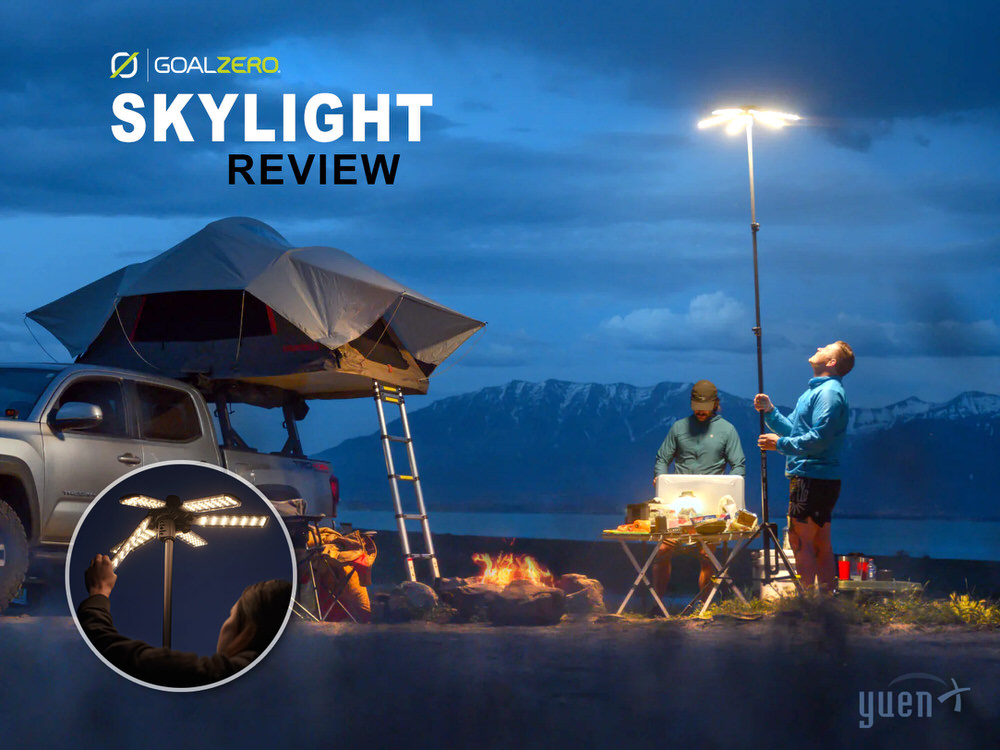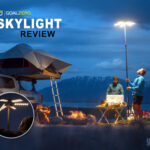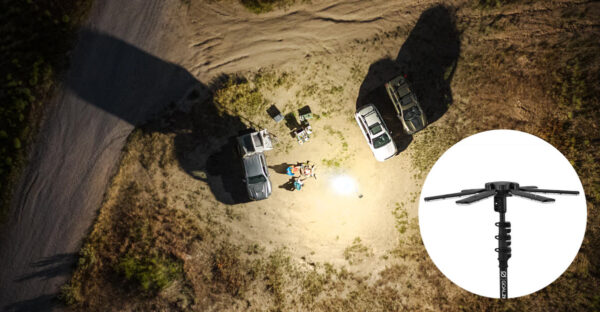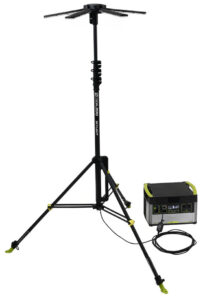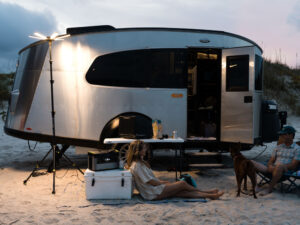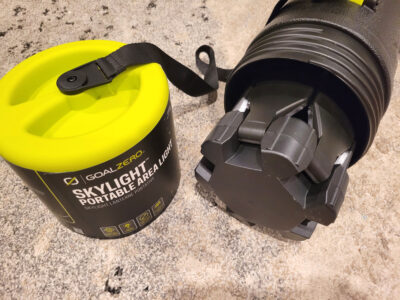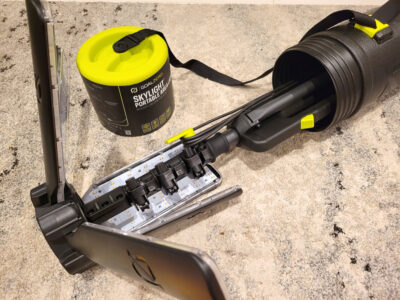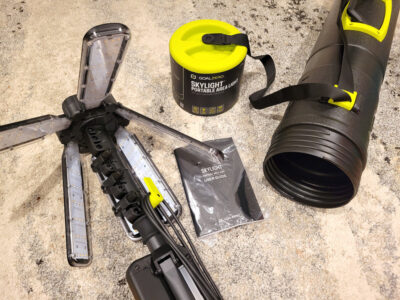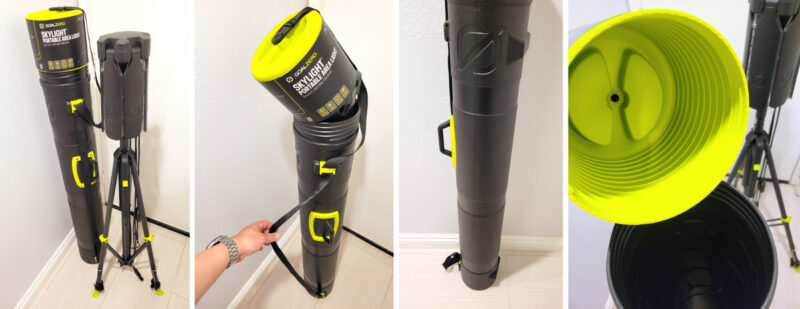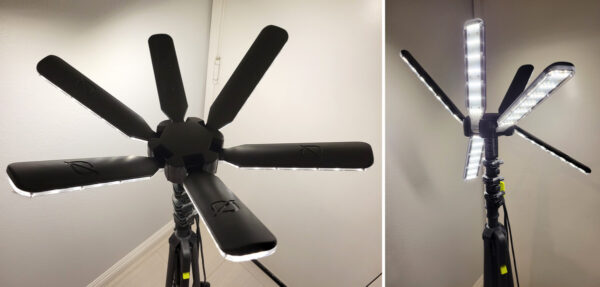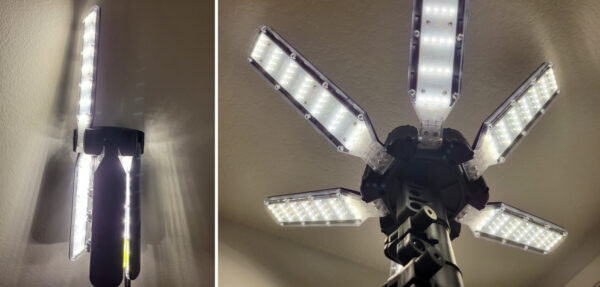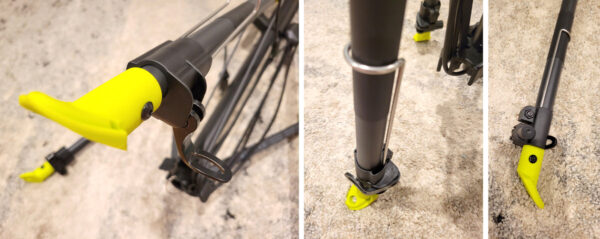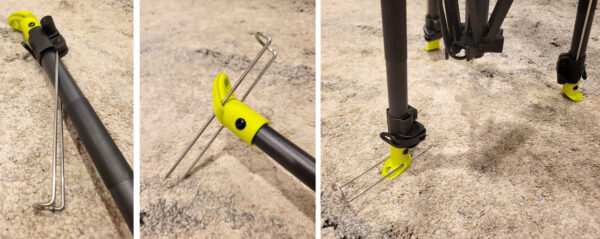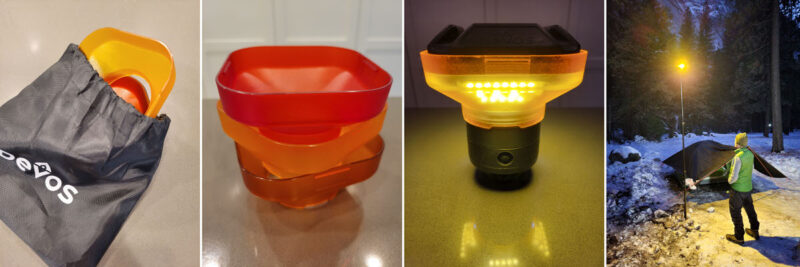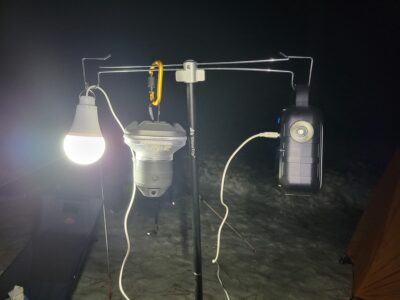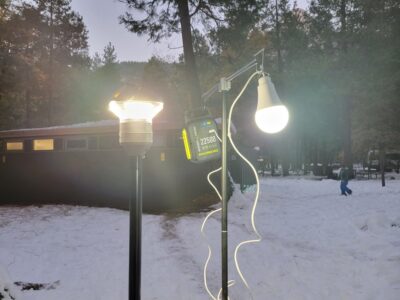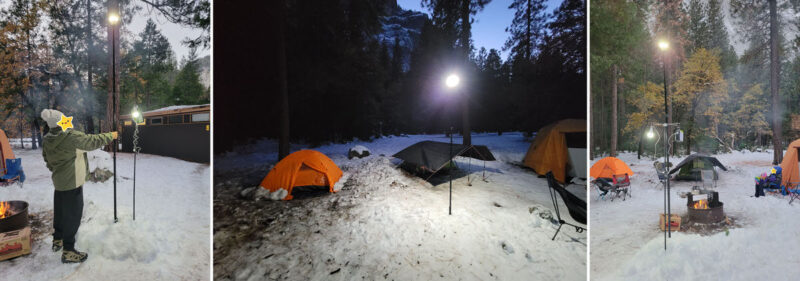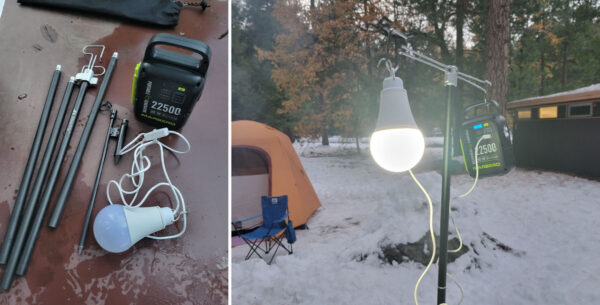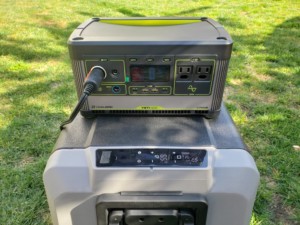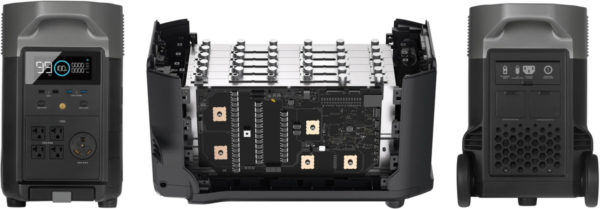Goal Zero Skylight
Contents
Worth Buying?
Goal Zero’s Skylight is expensive. It also is heavy. Why would anyone want to buy one? I initially dismissed it, but after much thought I actually found some really good use cases calling for one and some against. To see why, I remembered Goal Zero’s humanitarian roots and its mission to enable every human being to receive reliable power. In particular, in countries and places where electricity may not always be readily available but could mean the difference between life and death.
In fact, the company’s founder made it his mission to bring electricity to the Republic of the Congo as part of his humanitarian efforts in 2007, and that philanthropy appears to live on in Goal Zero’s DNA to this day. Life-bringing power in remote areas where quality, reliability, durability, and longevity are paramount in the face of extreme temperatures and poverty. These became important points as I started to wrap up writing this review and asked myself why anyone would want a Skylight.
What is the Skylight?
For those of you wondering what the Skylight is (Goal Zero | Amazon), it is a lighting product designed to illuminate small and large areas. Its concept is simple: project light downward high from a telescoping pole so a larger ground area would be lit. The higher and brighter the light, the more space lights up underneath. There are additional benefits to this method that will be covered later.
I first came across this very concept of raising a light up on a telescoping tripod with the Devos LightRanger 1200 in the summer of 2022. It was a battery-powered light with 1/5th the brightness of the Goal Zero (GZ) Skylight for roughly 40% lower cost. As much as I liked the Devos, I questioned how long it might last for everyday, long-term use after I took it camping in Yosemite for Thanksgiving last year. Some of the supporting parts looked flimsy and will likely need replacement or repair after prolonged use. Cheaper lighting alternatives were available but none as elegant as the Devos. I actually wondered at that time why Goal Zero did not have such a product available, but little did I know that just a year later, the company would actually release the Skylight. Did somebody read my mind??? How about a battery-powered car freezer like the AcoPower LiONCooler, Goal Zero? One can only dream.
Let’s take a closer look at the Skylight.
Analysis
When I purchased the GZ Skylight to see how it would compare against the Devos, I was VERY skeptical. My initial thoughts were, “Why would ANYONE spend that much money on the Skylight?” I had also questioned the portability of a light weighing 14 lbs (18 lbs with its case) when the LightRanger 1200 was an estimated 20% smaller (overall) and 70% lighter at just 4 lbs. The old adage very much applies here: “You get what you pay for.”
Quality, strength, and reliability had been part of Goal Zero’s DNA for over a decade. I can confidently state this because I had purchased and reviewed so many power stations over the years, Goal Zero had consistently commanded best-in-class material, features, and reliability over its competition, allowing their brand to charge a higher price premium. That had increasingly not been the case with their Yeti X power stations lately as competition had heated up so much, EcoFlow (EF) surprised me the most among them all over the past 1.5 years with the release of some forward-thinking products. Thankfully, rivalry is good for consumers as that pushed Goal Zero to finally launch the LiFePO4-based Yeti Pro series on October 3, 2023 in an attempt to reclaim its crown.
Stay tuned: I may review their Yeti Pro 4000 (Amazon | Goal Zero) power station in the near future. I had actually been thinking about a whole-house backup system to pair with roof-mounted solar panels, and both the GZ Haven Home (Amazon | Goal Zero) and EF Smart Home Panel ecosystem looked enticing. (Neither the Tesla Powerwall nor LG Chem appealed to us for a variety of reasons.) This may come as a surprise for many of you, but roof solar panels without a battery backup will not provide power when the electric grid shuts down.
Packaging
From the outset, the Bazooka-looking hard case the Skylight was housed in looked intimidating. Did a weapon of mass destruction get delivered to my door? It had a collapsible carry handle in the middle, two stump feet on one side to lay it to rest on, and a strap to put over your shoulders. The cap unscrewed and I was ready to put the anti-tank rocket launcher on my shoulder to launch whatever was inside the case! Whoever the designer was at Goal Zero should be patted on his or her back for that design. Whether it was intentional or not, it made the Skylight seem like it could be taken to war. I would not be surprised if it did.
Hardware
The Skylight (47.6″ H x 5.8″ W x 5.8″ L) was best pulled out of its case (49.2″ H x 6.6″ x 6.6″) while laying on its side. Slowly but surely, it then emerged like a butterfly out of its cocoon ready to spread its 6 individual wings (pedals) housing 168 LED lights capable of outputting 400, 1350, 3500, or a whopping 6000 lumens at a power consumption rate of 4W, 12W, 34W, or 67W, respectively. Its telescoping tripod base extended between 4′ – 12′ high.
Material quality was immediately noticeable: solid construction (made of steel and iron) for durability, smooth opening and closing of the tripod legs through a green push-button on the sliding handle; and green, cushioned silicone legs that minimized the risk of scratching any surface while integrated holes allowed included stakes (stored in each leg) to hold the tripod firmly in place. They would not do well on sandy beaches, snow, soft ground, or hard surfaces, however: you will want to invest in relatively inexpensive anchors for those environments. Devos designed their pole to be detachable from the tripod so it could be attached to a ground stake instead. This allowed their LightRanger to be driven into hard ground and stay put.
The bottom of the tripod had a hook from which you could attach weight to further help secure the Skylight. You will want to do this in windy conditions or to keep children from accidentally tripping it over. Trust me on that one as a former photographer who had a tripod-mounted Canon Speedlite 600EX II-RT ($630 at the time) fall and break during a wedding assignment. Could the light panels survive a fall from 12′ high? Probably, but I did not test that.
Each leg could be independently extended to account for uneven surfaces, and three quick-release adjustment clamps at the top allowed the tripod to telescope between 4′ and 12′ tall.
At the very top were six LED light panels that each could be independently swung up and down at a 180-degree angle. They could not be rotated sideways nor could any panel be separately turned on or off to conserve energy. That was one feature I loved about the Devos LightRanger: the ability to only light up 1, 2, or all 4 sides to both save on battery power and to only illuminate part of the camp site to keep light pollution towards the neighbors in check. Believe me when I say that your neighbors would thank you for that. Because the Skylight could only have ALL panels on or off, I considered using it mostly in a work environment, a tailgating party, sports event, or at a truly remote location where nobody would complain about light polluting their side. Granted, one could tuck the unused panels into the pole and point them to the area to be lit, but that would be a waste of power. When not in use, I would have much preferred the ability to switch individual (or a subset of) panels off.
On the flip side, the Skylight’s large number of panels, higher LED count, and significantly greater maximum brightness made it more ideal for illuminating large areas than the LightRanger, including fields for an after-hour soccer game, tennis match, BBQ cookout, tailgating, or film making.
The light panels could not be detached for use as independent flashlights that some cheap alternatives offered. I appreciated the Devos in that its lighting unit could be removed and attached to a backpack, off a tree branch or rope, the belt of my pants, or a standup paddleboard for night-time exploration with its IPX6 water rating. IPX6 meant the LightRanger could resist high-pressure, heavy sprays of water and could be briefly dunked in water.
In contrast, the IPX4 rating of the Skylight guarantees it could withstand 10 minutes of water splashing and spraying like that experienced in moderately heavy rain. Heavy rain could pose a problem if exposed for hours, and thus a surprise that Goal Zero did not seal it for IPX5 or higher. The “X” in IPX means neither Goal Zero nor Devos rated their products for dust protection, but that does not mean they are not dust resistant. Companies often skip testing against dust to save money and keep cost low. IPX4 is commonly found in workout earbuds.
A nice-to-have that most light stands I had researched did not have was a motion-activated and/or dusk-to-dawn sensor to additionally save on battery power. Devos LightRanger made such accessory available in mid-October 2023 with its Motion Sensor add-on.
Battery And Charging
The top-most portion of the tripod where the light panels extended from housed a built-in, 33Wh Li-ion NMC battery rated for up to 8 hours on the lowest brightness (400 lumens consuming 4W of power). The high setting (3,500 lumens) used 34W of power, depleting the battery in just a bit after 60 minutes. The highest brightness (“Boost” @ 6,000 lumens) was only available with an external power supply attached and drew 67W.
Skylight is capable of outputting 400, 1350, 3500, or a whopping 6000 lumens at a power consumption rate of 4W, 12W, 34W, or 67W, respectively.
The Devos’ 35.5Wh battery, in comparison, lasted up to 16 hours at the lowest setting (a mere 30-lumen brightness sipping 2.4W) and 3.5 hours at High (1,200 lumens @ 11W). The Skylight was just a little more efficient than the Lightranger and underscored Goal Zero’s obsession with trying to make their products as energy-efficient as possible.
Although a battery was built into the Skylight, it shone by pairing it with a compatible power station. Goal Zero will have you think that its Yeti series is the best choice, but the majority of power stations with a 12V car port (from the likes of Jackery, EcoFlow, and Bluetti — or even your car’s cigarette lighter) can be used. This will both charge the Skylight’s built-in battery while also providing enough power for it to be continuously used. Keep that in mind: the light could be used while still charging. With a power station and solar panel, the Skylight could virtually run forever — and provide a lifeline for a disaster-hit or remote area.
Where the Yeti did become advantageous over most of its competition was its 6mm DC port for a smaller, snugger, and more weatherproof fit. The 6mm connector could be found at the end of the Skylight’s 17-foot cable (10′ usable when pole is fully extended) where the 6mm-to-12V adapter was connected. It was also that cable where the control button was found: long-press to turn on/off, and short-press to cycle through the 4 brightness levels. Four blue LEDs indicated the battery level in 25% increments. As expected, the connections between the cable and adapter were snug and weatherproof.
Goal Zero took a misstep by not making a 6mm-to-USB-C adapter available to allow the built-in battery to be charged from a standard USB-C source or battery bank. That standard is much more ubiquitous and readily available than a 12V or 6mm port. In fact, the European Union (EU) recently forced manufacturers (such as smartphones, headphones, cameras, and tablets) to use USB-C as the de facto charging standard for the EU by the end of 2024.
Charging took about 2 hours at 18W (via 6mm or 12V ports) from empty to full. The GZ Yeti 500x’s 12V port charged at only 11W, but that may be due to how the port was regulated.
Battery Chemistry
The built-in battery could not be easily replaced, but its cells were made by a Tier-1 manufacturer: LG. This is important for both safety and quality reasons to minimize the risk of explosion, fire damage, and injury.
Li-ion NMC batteries often receive a bad rap for being unsafe. Numerous news stories showcase them exploding in electric bicycles and cell phones and not lasting as long as LiFePO4 cells. The truth is, both NMC and LiFePO4 (LFP) are Lithium-ion chemistries with unique advantages and disadvantages, and with the proper designs and protections, NMC can be quite safe.
For more details on Li-ion NMC vs LiFePO4, scroll down to the “Other Useful Topics” > “Battery Technology and Safety” section.
For the purpose of the Skylight, using NMC made sense for portability and fast charging, and with that battery chemistry, the light could be used in temperatures between 4F – 140F.
Lighting (and Bugless Camping?)
At its brightest setting (6,000 lumens) and tallest configuration (12′), Goal Zero claimed coverage for up to 150′ in all directions from the center where the Skylight is set up. Compare that to the Devos LightRanger’s 25′ from the center at 1,200 lumens at up to 8.7′ high, and the difference is bright (literally by 5x) and clear: Skylight is superior in brightness and ground coverage.
The Skylight only provided a warm, soft-white light of 3,250K (Kelvin) whereas the LightRanger output an almost pure-white of 5,000K (similar to the sun). This can be important for those where the color temperature can be a factor, such as for photography work, although a camera could offset that with a custom Kelvin setting. I am more of a fan of the daylight color for reading and work, but my wife prefers warmth throughout the house. We both do agree that a campsite should be a romantic, welcoming amber or soft-white that the Skylight outputs.
Be aware that unlike the Devos, the Goal Zero did not have any color filter kits available to modify its light temperature. Several of my fellow overlanders/boondockers/campers, in fact, cited that as important because a red (1,000K) or amber (2,200K) light was easier on the eyes for astronomy and star gazing, and could also help minimize the amount of bugs flying towards the camp. The ability to change colors enabled versatility in use. So, we hope that Goal Zero will someday make available a filter kit or release an updated model with color-changing LEDs that could be controlled by an infrared or Bluetooth remote or switch.
We found that having a warm light up 12′ was high enough for the bugs to not bother us when we camped near a Southern California beach in October 2023. The higher the light was, the more the insects seemed to fly towards it and away from our faces. Some of them did not get that memo, however. So, expect a bugless, not bug free experience.
Photography And Videography
You may have noticed from my Devos LightRanger review that I had used it as a light source for product photography just to see if it could be done. It worked but was not ideal. The Skylight would work much better due to the large, bright, soft light it could cast — ideal conditions for portraits when paired with an inexpensive modifier. The photo of the Mickey Mouse plush doll was taken with just the Skylight pointed in various directions and utilizing the white walls as a reflector for bounce lighting. The result was an evenly-lit doll with soft tones. Skylight for outdoor AND portrait lighting? Highlight the shiny curves of your overlanding rig in Alabama Hills, CA, in front of Mount Whitney? Film an outdoor cooking show in the woods? Show off your abs during a workout session? Yep, it could be done in a pinch.
Competitors
What are the alternatives besides the traditional LED or propane camp lights? Are there any that can be raised up high to illuminate a large area? Here were those I had previously used or considered:
Light Stands
- Devos LightRanger 1200 – See our Review
- Pros: Expands 9′ up, has built-in 38.5Wh Li-ion NMC battery, control to minimize light pollution, sleek and fairly compact packaging, lightweight, color filter kit, motion/dusk-to-dawn sensor accessory, detachable light unit
- Cons: Not as well-built/sturdy, bright, or tall as Goal Zero’s SkyLight (Goal Zero | Amazon), pricey, some mechanical parts may not be reliable
- OVS UFO Solar Light and Speaker by Overland Vehicle Systems
- Pros: Expands 7.5′ up, main light has built-in 38.5Wh Li-ion NMC battery (10,400 mAh @ 3.7V) and can be augmented with 3x D batteries, solar panel built-in (Watts rating not specified by OVS), 3 removable pod lights (flashlights) with 6.7Wh battery each, detachable 5W Bluetooth speaker with 4.1Wh battery
- Cons: Not waterproof, pricey, bulky head unit, heavy (12.7 lbs), no remote control
- SeeDevil Work Light with Remote
- Pros: Extends 6.9′ up, is super bright, provides 360-degree illumination, can be remotely controlled, lamp is inflatable, and is weatherproof
- Cons: Very expensive, has no built-in battery (requires an external power source that can output 65W), cannot control its light direction, inflatable lamp may not last, and is heavy (13.1 lbs). The higher models require even more power and get significantly heavier
- Conpex Five-Panel Camping Light with Remote
- Pros: Extends 11.5′ up, is super bright, and can be remotely controlled
- Cons: Not waterproof, has no built-in battery (requires an external power source that can output a whopping 110W), cannot choose which panels to keep on or off to control direction of light, and has questionable build quality/longevity
- CMrtew Rod Light with Remote
- Pros: Extends 12′ up, is weatherproof and bright, can be remotely controlled, and is inexpensive
- Cons: Has no built-in battery (requires an external power source that can output 48W), is of questionable build quality/longevity, and cannot provide 360-degree coverage
None (but the Devos LightRanger and OVS UFO Solar) had a built-in battery and lacked the build quality, compactness, and feature set of the Goal Zero Skylight or LightRanger.
USB Lightbulb with Power Bank
Before having vertically telescoping lights, this was my favorite combination to light up the camp:
- USB Lightbulb: Onite / Powkey
- Lantern Pole: TooCust / Other poles
- Power Bank: Anker / Goal Zero Sherpa
The setup was not weatherproof, but certainly provided plenty of lighting around the camp for an affordable price. But, they do not provide the feature set of the Goal Zero Skylight or Devos LightRanger.
Headlamps and Lanterns
I have plenty of these in my camping arsenal. They are either worn on the head (headlamps) or sit somewhere on a table (lanterns) and do not provide the campsite with full-coverage lighting. Bugs love flying towards the light (and into our faces) while we are trying to have a conversation or eat dinner. Propane lanterns do kill bugs instantly and have the added benefit of outputting some heat. None provide the feature set of the Goal Zero Skylight or Devos LightRanger, including Goal Zero’s older lights & lanterns, surprisingly.
Conclusion
Goal Zero has been known for the quality, reliability, and safety of their products and the Skylight (Goal Zero | Amazon) is no exception. Its durable metal construction, energy-efficient use of the built-in Li-ion NMC battery, and high brightness levels make it an ideal accessory for construction sites, remote areas, tailgating, filming locations, and places hit hard by disasters where strength and reliability are important. It is capable of illuminating nearly an entire soccer field, and its adjustable panels give it some flexibility in what areas should be lit.
For casual campers, the Skylight is perhaps overkill and out of their price range, but those serious about a light that should reliably and safely last a long time — especially when paired with a power station and solar panel — ought to seriously consider it and not balk simply based on its higher price point. “You get what you pay for“, as the saying goes.
The Skylight could be improved by providing the ability to switch individual (or a subset of) panels on or off, offering a USB-C charging option, colored LEDs to adjust the light for specific occasions or use cases, increasing the IP water and dust protection rating to withstand heavy rain and sand storms, offering a smaller, lighter version for those seeking greater portability or affordability, and adding a motion and/or dusk-to-dawn sensor option for additional power saving.
Where To Buy
- Goal Zero
- Skylight (Goal Zero | Amazon)
- Beach and Soft Ground Anchors
- Power Stations
- Skylight (Goal Zero | Amazon)
- Other Lights
- EcoFlow
- Jackery Explorer Power Stations (NMC)
- Bluetti Power Stations (LiFePO4): EB70S (Amazon | Bluetti) – See our Review / EP500 (Amazon | Bluetti)
Related Posts
- Devos LightRanger 2000 vs 1200: Bright, portable, compact, full-coverage area light with battery and stand. Now brighter with remote control, built-in colored LEDs
- Devos LightRanger 1200: Portable, compact, full-coverage area light with battery and stand
- Temperature Control
- Mr. Heater Buddy Indoor-Safe Portable Propane Radiant Heater
- Outland Living Firebowl Propane Fire Pit (893 Deluxe) with Refillable Tank
- EcoFlow Wave Portable Air Conditioner
- Cooking
- ICECO 15.7″ Foldable Charcoal Grill – Compact for Tabletop
- Tomshoo vs Solo Stove Camping Stove
- Osba 1L Travel Rice Cooker 12V (2-4 Cups) For Cars (CFXBOB-MR C2)
- Backcountry Meals: RightOnTrek / Mountain House
- Power Stations / Solar Panels / Car Freezers
Other Useful Topics
Battery Technology and Safety
Goal Zero debuted with Lead-Acid batteries that were bulky and heavy. Today’s devices use Lithium-ion — commonly Nickel Manganese Cobalt (NCM) or Lithium Iron Phosphate (LiFePO4 / LFP) chemistries — for more power in a smaller, lighter package. NMC, however, is more volatile than LiFePO4 and becomes riskier as more cells are packed together. Goal Zero and Jackery used NMC for some time whereas EcoFlow and Bluetti use LiFePO4. Jackery launched its first LiFePO4 model in mid-June 2023 and Goal Zero in October that year.
- How much energy a battery can store is measured in Wh (Watt-hours), and how much power is used or produced in W (Watts)
- The higher the Watt-hour (Wh) capacity rating, the more dangerous the battery could become if not handled right
The quality of the battery cells and the BMS (Battery Management System) are crucial for safety.
Cell Manufacturers
Battery cells made by LG and Sony are among the best in the hobbyist world as are Sanyo/Panasonic and Samsung. Goal Zero uses LG. Jackery also uses LG or BAK (a leading Chinese brand). EcoFlow makes its own. During my years of research, I found that use of lower-quality batteries could pose a serious risk to life and property and should become a crucial part in deciding what to buy.
Safety
The second part in a battery’s safe operation depends heavily on the design and BMS (Battery Management System). Some BMS manufacturers, unfortunately, overstate their capabilities that could lead to catastrophic failure.
- Design should allow for proper, thermal cooling, use quality components, and obtain proper certifications
- Batteries made by known manufacturers are less likely to fail
- BMS should sufficiently restrict the battery from going past its capabilities
Li-ion: LiFePO4 vs NMC
There had been a lot of debate over whether Nickel Manganese Cobalt (NMC) or Lithium Iron Phosphate (LiFePO4) was better. Both are Lithium-ion batteries. Goal Zero, Jackery, and most of today’s power station manufacturers use NMC, but why do EcoFlow and Bluetti use LiFePO4 when they are bulkier and heavier? There are important distinctions, but the best battery is the one that meets all or most of your unique needs.
Charge Cycles
One of the most significant differences — and buying factors — is the charge cycle count for both battery chemistries. It measures how long the battery can be used for before it must be replaced or thrown away. LiFePO4’s count is as high as 4,000 cycles (as of 2023) whereas NMC is 500+. However, both have a useful life that can range between 3,000 – 5,000 cycles (even as much as 7,000 with proper care). But how does the count determine longevity?
Let’s look at Li-ion NMC as an example. It loses about 20-25% of total capacity after every 500 charge cycle. That means after the first 500 cycles, the battery drops 20% from when it was new, then another 20% after the next 500 cycles, and 20% again after that one. It would take roughly 1,500 charging cycles to have the battery last only half as long as when it was brand-new. Thus, it should be usable for 2,000+ cycles or about 6-10 years. Li-ion LiFePO4 can last longer.
CAUTION: Lithium-ion (LiFePO4 and NMC) batteries do NOT like to remain discharged at 0% for prolonged periods of time. If you let your battery stay at 0% for too long, you may not be able to charge it again without specialized equipment. Keep them at between 20-80% while in storage to maximize their lifetime.
LiFePO4 Advantages
- Safer, less volatile, and thus cheaper to manufacture
- Higher charge cycle: 1500-2000 (10+ years). NMC: 500+ (6-10 years)
- Usable in more extreme temperatures (-4F/-20C to 176F/80C). NMC: only 140F/60C max
- Holds 350-day charge. NMC: 300
NMC Advantages
- Smaller and lighter. Allows for more portable products
- Faster charging

